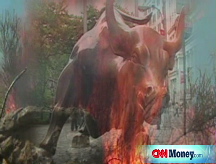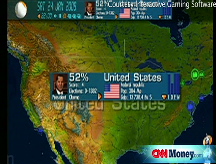Wall Street's inauguration rally
Investor euphoria could propel stocks this week, but the longer-term outlook is less upbeat.
NEW YORK (CNNMoney.com) -- Optimism about Barack Obama's first 100 days as president is running high, but Wall Street's post-inaugural celebration may well be short-lived.
"I think there's going to be something of an Obama honeymoon for a few weeks," said Terry L. Morris, senior equity manager at National Penn Investor Trust. "But I think there's still a lot of pessimism out there about the economy."
Since 1932, stocks, as measured by the S&P 500, have gained an average of 1.6% in the first 100 days of a new president's term regardless of the party. The S&P 500 has gained 0.9% on average under a Republican president and 2.2% under a Democrat like Obama, according to research by Standard & Poor's chief investment strategist Sam Stovall.
While a gain is a gain, a 2.2% rise following a year in which the S&P 500 lost 38% - and saw its worst year since the 1930s - does not suggest the rallying cry of a new bull market.
In fact, Wall Street could very well see the same market reaction that briefly followed both the November election and the start to 2009, said Joe Arnold, wealth manager at Dawson Wealth Management.
"Both times, the optimism had an emotional effect on the stock market for a few days or weeks," said Arnold. "But then the happiness wore off and people returned to the reality that we are still in this crisis and we don't know when it's going to end."
History favors the Democrats: Similar to the first 100 days, stocks tend to perform better for the rest of the year when the Democrats are in power, according to S&P. In the subsequent eight months, stocks on average lose 7.7% under Republicans and gain 4.8% under Democrats going back to 1932.
"Election year history favors a Democratic president, but nothing is certain in this world except death, taxes and volatility - of share prices and emotion," wrote Sam Stovall, S&P's chief investment strategist in a recent note.
He noted that investors tend to approach the periods surrounding a new president's term with optimism, despite a lack of convincing evidence to justify those rose-colored glasses. Although the first 100 days and the full year are positive on average, there have been plenty of exceptions.
In the 19 election years since 1932, stocks only posted full-year gains 60% of the time under Democrats and 55% of the time under Republicans.
The hope surrounding Obama's election has been compared to the hope felt after John F. Kennedy's election in 1960.
For Wall Street, that optimism correlated with higher stock prices. During the first 100 days of JFK's administration, the S&P 500 gained 8.9%. It gained another 9.6% in the rest of the year, according to S&P.
But the stock reaction is likely to be different this time as President-elect Obama faces what many describe as the worst financial crisis since the Great Depression. Even with an $825 billion stimulus plan being debated in Congress and the likelihood of further capital infusions from the Federal Reserve, the recession isn't expected to be over until late this year or early next.
Also, investors may have already shown their enthusiasm for a new administration and the eventual end to the recession in the recent rallies. As a result, there may not be much of a follow-through this year.
Between the bear market lows of Nov. 20 and Jan. 6 of this year, the S&P 500 gained 24%. Since Jan. 6, the S&P 500 has lost 6%.
Stocks are perhaps due for a bigger bear market rally in the first half, but the outlook is so cloudy it's hard to see what could cause it, said Drew Kanaly, chairman and CEO at Kanaly Trust.
"I think a lot of investors are waiting for the new administration to come in," he said. "They want to see what they are going to do first before they start participating more fully in the market." ![]()



